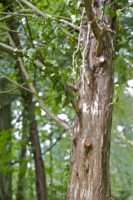Schwanberg and the Pencil Cedar

In the 12th century my home town, Volkach, became part of the county of Castell, which belonged to – you might have guessed – the Counts of Castell [1]At that time it actually wasn’t a town yet, but documents show that by 1258 it was a town (‘in civitate nostra Volka’).. Quite a bit later, in 1896, Alexander Graf zu Castell-Rüdenhausen married Ottilie Freiin von Faber and the name of the pencil manufacturer Faber changed to Faber-Castell.
 Except this link to Faber-Castell there isn’t really much of a “pencil link” in the surrounding area of Volkach. All the exiting pencil stuff is happening about 100 km further South where you’d find the big pencil manufacturers like Staedtler, Faber-Castell, Schwan-Stabilo and Lyra.
Except this link to Faber-Castell there isn’t really much of a “pencil link” in the surrounding area of Volkach. All the exiting pencil stuff is happening about 100 km further South where you’d find the big pencil manufacturers like Staedtler, Faber-Castell, Schwan-Stabilo and Lyra.

I wrote there isn’t much of a “pencil link” here – well, the area around my home town can boast with one other link to the world of pencils, even though it is rather unknown. Trees from North America  were planted in Germany to test the suitability of the wood for use in pencil production …and some of them were planted on Schwanberg [2]The Schwanberg isn’t really a hill, but an elevation (474m / 1555 feet) – about 200m above the surrounding area. According to legend Saint Hadeloga (sometimes called Adeloga or Hadla) … Continue reading, an elevation not far from the town of Castell, by the Counts of Castell – to test the suitability of the wood for use in pencil production. The trees brought over from North America were the Pencil Cedar (juniperus virginiana) and the Eastern White Pine (pinus strobus). You can still find some of the Pencil Cedars near Castell. 100 years ago there were also many well established Pencil Cedars North East of Faber-Castell’s home town, Stein, planted by Faber, which probably didn’t survive [3]This tree was first introduced to Europe in the 17th century. Faber is supposed to have planted, between several thousand and several tens of thousands of these trees in the 19th century, depending … Continue reading. These trees are not really used any more for pencil production, but if you have an old pencil that is more than 70 years old, the wood might be from a Pencil Cedar.
were planted in Germany to test the suitability of the wood for use in pencil production …and some of them were planted on Schwanberg [2]The Schwanberg isn’t really a hill, but an elevation (474m / 1555 feet) – about 200m above the surrounding area. According to legend Saint Hadeloga (sometimes called Adeloga or Hadla) … Continue reading, an elevation not far from the town of Castell, by the Counts of Castell – to test the suitability of the wood for use in pencil production. The trees brought over from North America were the Pencil Cedar (juniperus virginiana) and the Eastern White Pine (pinus strobus). You can still find some of the Pencil Cedars near Castell. 100 years ago there were also many well established Pencil Cedars North East of Faber-Castell’s home town, Stein, planted by Faber, which probably didn’t survive [3]This tree was first introduced to Europe in the 17th century. Faber is supposed to have planted, between several thousand and several tens of thousands of these trees in the 19th century, depending … Continue reading. These trees are not really used any more for pencil production, but if you have an old pencil that is more than 70 years old, the wood might be from a Pencil Cedar.

More about the Pencil Cedars at Lexikaliker’s blog post “Der Graphit” (German) (Link to the Google Translation)
References
| ↑1 | At that time it actually wasn’t a town yet, but documents show that by 1258 it was a town (‘in civitate nostra Volka’). |
|---|---|
| ↑2 | The Schwanberg isn’t really a hill, but an elevation (474m / 1555 feet) – about 200m above the surrounding area. According to legend Saint Hadeloga (sometimes called Adeloga or Hadla) built an abbey (nunnery) on Schwanberg. She was the daughter of Karl Martell (Charles the Hammer). He repudiated her when she vowed virginity (so she is not mentioned very often in history) but they reconciled many years later. She is actually an aunt of Charlemagne, King of the Franks, and she is the patron saint for fever. |
| ↑3 | This tree was first introduced to Europe in the 17th century. Faber is supposed to have planted, between several thousand and several tens of thousands of these trees in the 19th century, depending on which source you check. I assume many must have survived outside Schwanberg, but it is unknown how many are left and where they are. One of Lexikaliker’s blog posts indicates that the trees planted by Faber near Nuremberg did not survive. Other Pencil Cedars planted in Germany did not survive either. |
Schwanberg and the Pencil Cedar Read More »